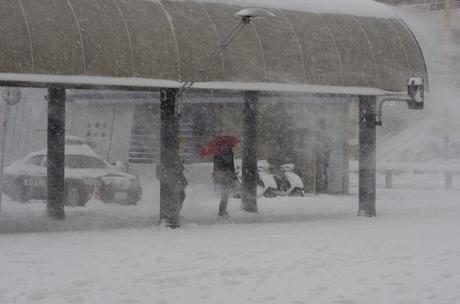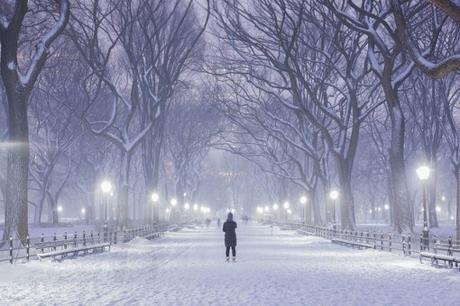What is a Blizzard?
While snowstorms are a common occurrence in many areas during the winter months, blizzards are a rarer occurrence. In order for a snowstorm to be classified as a blizzard it must meet the following criteria: a large amount of snowfall, winds greater than 56 km/h (35 mph), and less than ¼ of a mile visibility. These conditions must last for over three hours for a blizzard to occur. In short, a blizzard is a severe snowstorm with strong and powerful winds in excess of 35 mph for more than 3 hours and visibility of less than a 1/4 mile. During a blizzard, the temperature is often below 0 degrees, because of this frostbite and hypothermia are common. In the United States, blizzards occur most frequently in the Plain States, the Northeast, and on mountain tops, although they can occur almost anywhere that gets snowfall.
My favorite thing of all time is a New York City weekend when there’s a blizzard. Everything gets really quiet, and everyone goes to the movies and the park.
-Idina Menzel

Facts of Blizzards
1. A blizzard is a severe snowstorm characterized by strong sustained winds of at least 56 km/h (35 mph) and lasting for more than 3 hours.
2. Two legendary blizzards occurred in 1888. The first is known as the schoolhouse blizzard. It occurred across the Great Plains and was so named because of the school children stranded in their schoolhouses. About 235 people lost their lives. A large portion of the number of deaths was of school children who had attempted to walk home. The second of the blizzards is known as the Great Blizzard of 1888. New Jersey, New York, Massachusetts, and Connecticut were battered with nearly 50 inches of snow. The area came to a complete stand still and people were trapped in their homes for a week. Over 30 people were killed.
3. The first blizzard announced as a Federal Emergency was in 1977. It occurred in the southern region of Ohio and New York. It lasted for 5 days and the snow was 12 inches thick.
4. A huge blizzard in 1993 effected huge portion of the United States and Canada. It resulted in over 10 million power outages as well as the death of over 300 people.
5. The snowiest place in the United States is Rochester in New York. It often receives more than 8 feet of snowfall in a year.
6. When watching the weather forecast, a “Winter Storm Watch” may be issued in advance which means that there is a possibility of winter storm affecting your area although not definitely on the way. A “Winter Storm Warning” indicates the need to be ready for a blizzard that is on its way or already taking place.
7. It is not suggested to go outside during a blizzard as it increases the chance of hypothermia, accident and death.
8. Blizzards that occur on the East Coast are commonly known as Nor’Easters. Because of the presence of the Atlantic Ocean, the storm blows over the ocean and can last for up to 24 hours and dumps huge amounts of snow over the area.
9. If you need to travel by car in an emergency during a blizzard, you must have an emergency aid kit which should contain water, jumper cables, road flares, tow rope, non-perishable snacks that should help in case you get stuck on snow or your car breaks down.
10. If you live in an area in which blizzards can occur, you should always be prepared. You should make sure you have enough food and supplies. The supplies you should have include a radio with spare batteries, candles, a charged cell phone and lots of blankets to keep warm. Often children who are caught outside their homes when a blizzard begins have gotten lost as a result of the blinding snow.
11. In order to adapt to living in blizzard prone areas, the people of central Canada and mid-western USA build their homes with sloped roofs in order to avoid accumulation as the snow instead falls off.
[Sources]
How Do Blizzards Form?
A blizzard is a long lasting and intense snowstorm with very strong winds. Generally, blizzards form when cold polar air meets warm, moist air from lower latitudes.
Three things are needed for a blizzard to occur, cold air at the surface, lots of moisture, and lift:
1. Cold air (below freezing) – In order for there to be snowfall, the air temperature both up in the clouds and down at ground level must be cold. If the air temperature is warm near the ground, the snow will melt before the reaches the ground causing rain instead.
2. Moisture – This is known as water vapor. An excellent source of water vapor is when the air must blow across a large body of water, such as the ocean. As the airs blows over the water, some water is evaporated into the air. This is water vapor.
3. Warm, rising air – Warm air must rise over cold air in order for a blizzard to form. This can happen in two ways. The wind can pull warm air from the equator towards the poles, and cold air from the poles towards the equator. When warm and cold air meet, a front is formed which results in participation. If warm air rises up a mountaintop it can cool as it rises, forming clouds and blizzard snows.

Effects of Blizzards
1. A blizzard has the ability to put a city into standby, sometimes even for days. It can make driving conditions impossible and results in kids not being able to get to school as well as adults not being able to get to work. This in turn means school and businesses close and people are housebound.
2. Low air pressure during a blizzard can make breathing difficult for some people.
3. Electrical wires can be damaged resulting in a loss of electricity to homes. People are left without the use of computers, TV’s, appliances, and lights.
4. Anyone caught outside in a blizzard is at risk of getting frostbite or hypothermia.
5. A blizzard can cause damage to property, including roof cave-ins and broken windows. Falling trees can also damage cars.
6. Blizzards can cause car accidents and people can also get stuck on highways in their cars if they happen to be on the road when the blizzard hits.
7. Blizzards are life threatening and people have lost their lives because of them.
8. Blizzards hurt the economy as businesses lose money when people can’t get to work.
9. When transport routes and shops close during a blizzard there is a chance of food and water scarcity if the blizzard lasts for an extended period of time.
10. Even after the blizzard has passed it can take days for a city or town to get back to normal. Normal travel is particularly impacted because of the difficulty with plowing the large accumulations of snow.
11. Because of freezing temperatures, trees, plants, and crops can be destroyed in a blizzard. Forceful winds combined with a temperature that is around freezing can have the same effect as temperatures of more than 30 degrees below freezing on crops. In order to adapt to this, people living in areas prone to blizzards often plant wheat crops in the winter months.
12. Trees often lose their limbs due to the extreme winds, as well as damaging the tree; this can also damage property as well as injure people.
13. There is a high risk of flooding following a blizzard. When the temperature starts to rise and melt the snow, it can melt at a faster pace than the ability of the land to absorb it.
14. As well as being life threatening to humans, blizzards are also life threatening to animals. They can die if exposed to extreme cold temperatures. They can also die if they are stranded somewhere without food and water. Pets should be brought inside during a blizzard.
References

